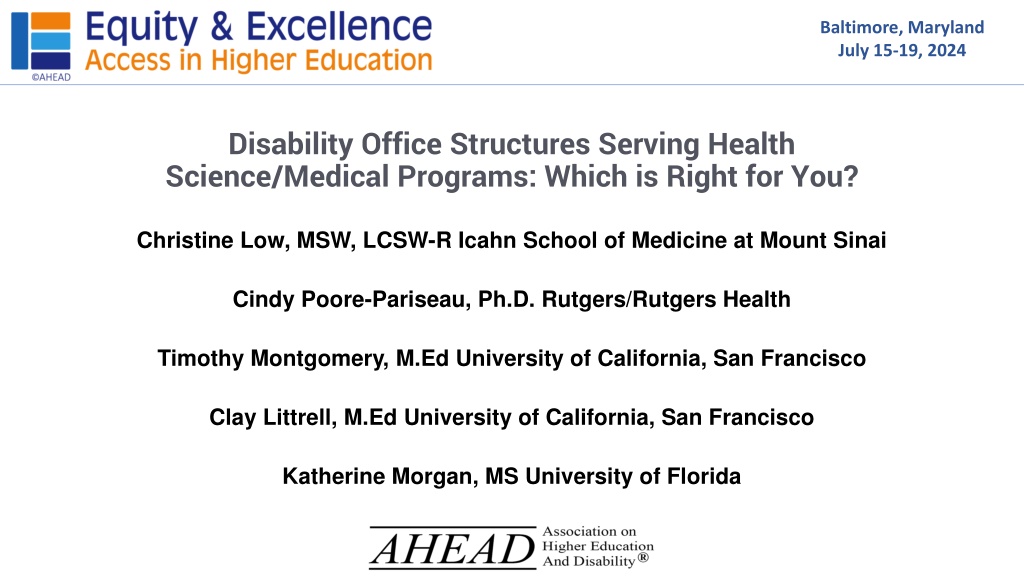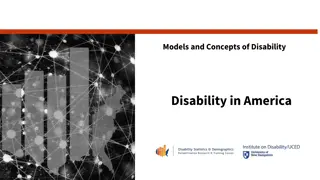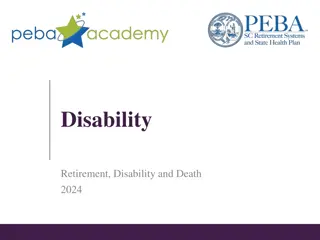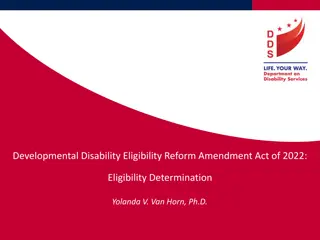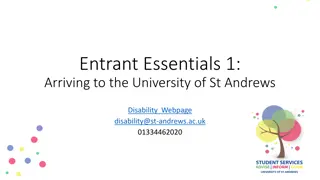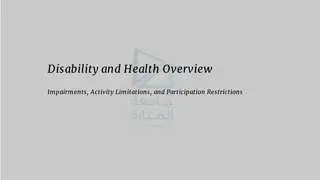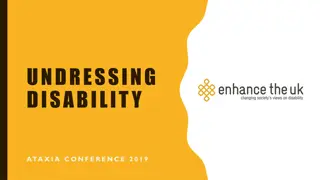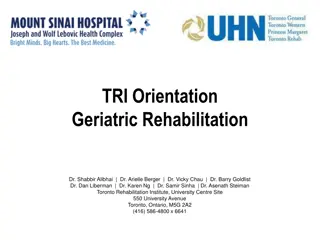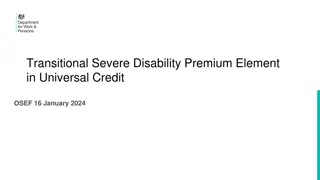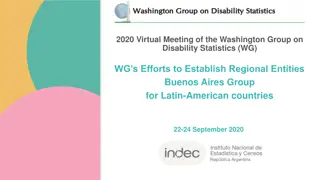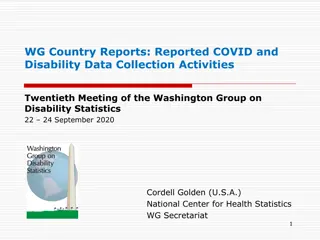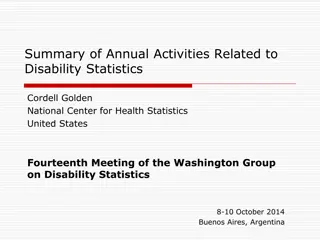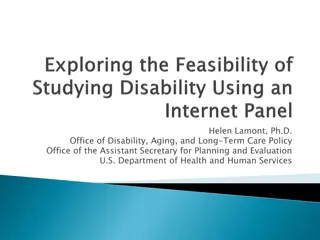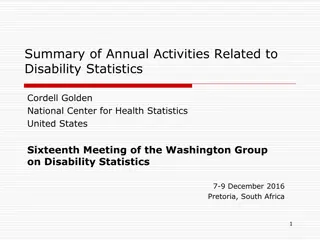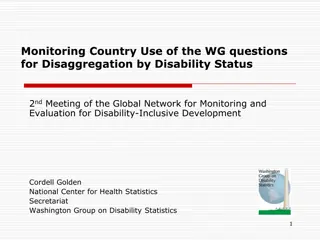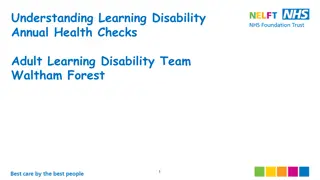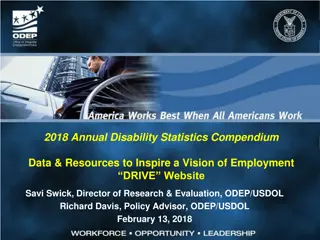Disability Office Structures for Health Science Programs
Learn about different disability office structures serving health science programs. Explore models from Rutgers Health, Icahn School of Medicine at Mount Sinai, University of California, San Francisco, and University of Florida. Understand their approaches and considerations for implementation.
Download Presentation

Please find below an Image/Link to download the presentation.
The content on the website is provided AS IS for your information and personal use only. It may not be sold, licensed, or shared on other websites without obtaining consent from the author.If you encounter any issues during the download, it is possible that the publisher has removed the file from their server.
You are allowed to download the files provided on this website for personal or commercial use, subject to the condition that they are used lawfully. All files are the property of their respective owners.
The content on the website is provided AS IS for your information and personal use only. It may not be sold, licensed, or shared on other websites without obtaining consent from the author.
E N D
Presentation Transcript
Baltimore, Maryland July 15-19, 2024 Disability Office Structures Serving Health Science/Medical Programs: Which is Right for You? Christine Low, MSW, LCSW-R Icahn School of Medicine at Mount Sinai Cindy Poore-Pariseau, Ph.D. Rutgers/Rutgers Health Timothy Montgomery, M.Ed University of California, San Francisco Clay Littrell, M.Ed University of California, San Francisco Katherine Morgan, MS University of Florida
Baltimore, Maryland July 15-19, 2024 Conference Civility Statement We ask you to join us in creating a culture that reflects Access and Inclusion and Civility and Respect this week and in all aspects of our organization.
Baltimore, Maryland July 15-19, 2024 Learning Objectives Participants will: Explore different DS health sciences office structures and their evolution. Consider if/how what they have learned fits into their own institutional needs and requirements. Review the steps necessary to implement changes
Baltimore, Maryland July 15-19, 2024 Agenda Presentation of each model Panel Questions and answers
Baltimore, Maryland July 15-19, 2024 Polling of Audience What is your institution type? Medical School Only Medical School within a larger university Health Sciences Schools only Health Sciences within a larger university Community College Health Center with health sciences schools attached None of the above
Baltimore, Maryland July 15-19, 2024 Model 1-Rutgers Health Rutgers Health is considered a campus 2 medical schools, dental, nursing and a variety of additional health related programs Established a separate disability office apart from the central disability office 400 accommodated students, 2 dedicated staff Liaisons to each program for communication purposes Prior to establishment of Rutgers Health ODS office, accommodations decisions made by staff within each program, as a portion of their jobs
Baltimore, Maryland July 15-19, 2024 Rutgers Health continued (a) Decisions made by committee All committee members are ODS staff (across all 4 Rutgers campuses) 20ish committee members discuss and decide on cases More complicated cases first discussed at the school level
Baltimore, Maryland July 15-19, 2024 Rutgers Health continued (b) Process for grievance and appeals Grievance related to discrimination: OEE-Office of Equal Opportunity Appeals related to accommodations (formal and informal processes) Informal is worked on by ODS- typically starting at a coordinator and moving to an assistant director or director if needed. Formal process goes to ADA coordinator.
Baltimore, Maryland July 15-19, 2024 Pros and Cons-Rutgers Health Pros Shared responsibilities for implementation Cons Large number of programs to understand. Liaison knowledgeable about curriculum (direct access) Large number of personalities Support for professional development Decisions made by a large group can sometimes be difficult Group think to bounce ideas off other knowledgeable professionals. Other school ODS do not understand what we do Technology support from centralized office
Baltimore, Maryland July 15-19, 2024 Model 2; UC San Francisco (a) Medical/Health Sciences/Graduate Division campus (no undergrad) o UCSF is a major medical center in the city of San Francisco, which includes: Medicine, Nursing, Dentistry, Pharmacy, Phys Therapy, Graduate Division (e.g., lab research) o Only students, no employees, fellows, post-docs, residents, etc. We have a campus wide DS office which serves all schools/programs o Students spread over 4 campuses and numerous clinical sites in bay area and beyond o Specialists in the office have specific schools that we are each lead for
Baltimore, Maryland July 15-19, 2024 Model 2; UC San Francisco (b) Currently approximately 600+ students; 3 staff oImplemented Accommodate system early 2022 We have the liaison model; one for each school and program oAlso have specific contacts in student life and department/adm.offices
Baltimore, Maryland July 15-19, 2024 Model 2; UC San Francisco (c) Decisions re: accommodations are made by DS office oImplementation of more complicated accommodations may involve the interactive process with schools and departments; oInteractive process may have to be completed prior to final decisions Appeals and Grievances are separate and clearly defined oOn website main page oOutline informal and formal processes oDocumentation, student names, and meeting notes protected in our offices under FERPA
Baltimore, Maryland July 15-19, 2024 Pros and Cons-UC San Francisco Pros Cons Large number of programs to understand Large number of personalities, deans, faculty, etc. Somewhat removed from programs, so making sure faculty are informed and trained is an ongoing challenge Liaison knowledgeable about curriculum (direct access) Assistive technology support from centralized office Consistent accommodations across campus Identify "need to know" faculty, staff, coordinators
Baltimore, Maryland July 15-19, 2024 Model 3-Icahn School of Medicine Large health system in Northeast with a medical and graduate school (no undergrad) oAround 1200 students total training in a variety of health science related graduate programs and a medical school oStudents spread across multiple clinical sites and facilities throughout the 5 boroughs, upstate NY and NJ DS Office for medical and graduate school oWork directly with both schools-no liaisons
Baltimore, Maryland July 15-19, 2024 Model - 3; Icahn School of Medicine Prior to establishment of the current SDS Office: oDS was assigned as 20% of predecessor s position oAccommodation decisions were made by committee in the medical school oServed 29 students total Current model o1.5 FTE oAccommodation decisions are made by the DS Office oServing 200+ students
Baltimore, Maryland July 15-19, 2024 Icahn continued-Process for decisions Standard vs. New/unique accommodations o Implementation of complicated or new accommodations may involve including faculty or administrators as part of the interactive process Accommodation letter o Goes to student o Accommodations can be used or not in various settings Implementation o Standardized language o Mistakes vs. failure Appeals/Grievance o On website main page o Outline informal and formal processes
Baltimore, Maryland July 15-19, 2024 Pros & Cons-Icahn Pros Imbedded in the school Direct access to faculty/leadership Consistent accommodations across campus Identify "need to know" faculty, staff, coordinators Direct access to clinical sites Seat at the table Support for professional development Cons No in house services Understaffed and no coverage No supports from centralized office or sounding board Limited assistive technology support
Baltimore, Maryland July 15-19, 2024 Model 4- University of Florida A DRP (Assistant Director for Health Science Programs) whose caseload/focus is specially health science programs within the central disability office o Previously was just part of an accessibility specialist role UF's Disability Resource Center has a team of 17 o Over 7,500 register students with the office o 10 positions are assigned a caseload of students o Assistant Director of Health Sciences caseload of 731
Baltimore, Maryland July 15-19, 2024 Model 4- University of Florida-continued (a) Health Science Programs at UF o MD, PA, Dental, Pharmacy, OT, DPT, VetMed, & Nursing o Most programs are on main campus, but some programs have alternate locations Meet regularly and work with liaison(s) from each program o Liaisons range from student affairs staff to Deans o Discuss accommodations in both didactic settings & clinical settings, updates within programs, and working together in technical standards and policies
Baltimore, Maryland July 15-19, 2024 Model 4- University of Florida-continued (b) Didactic approach to accommodation is similar to rest of university, BUT dedicated person to guide with the nuances of programs. oSome of the programs use DRC testing center, some programs facilitate their own testing accommodation oClinical accommodations oDifferent process than didactic. Meet with student, meet with liaisons, then send both their clinical letter
Baltimore, Maryland July 15-19, 2024 Pros & Cons University of Florida Pros Cons Not as directly involved with program/faculty, outside of liaisons Colleagues to soundboard off and collaborate with in office Able to bridge the gap for transition from undergrad Office is located on the main campus and not within colleges Have policies and other supports of central office Also have responsibilities outside of health sciences Streamlined to work with liaisons and specialize health sciences A large number of health science programs and students
Baltimore, Maryland July 15-19, 2024 Tell us about your institutions/Q & A What is your type of institution? What is your current model? What works well? What could be adjusted? What elements of the presented models might work for you?
Baltimore, Maryland July 15-19, 2024 Thank you for attending!
Baltimore, Maryland July 15-19, 2024 Discussion framework Presentation of each model Was there a previous model? If so, why was the model changed? What works well and why What needs further exploration and why Who was involved in discussions about the formation of the models?
